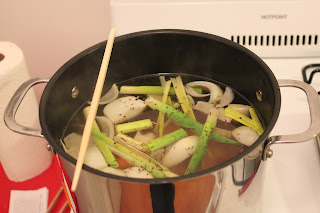At times I think my life is a lesson in circumventing the lessons that basic things have to offer. I have a long history of diving, feet first, into things and swimming around until I have a "jack-of-all-trades" understanding of these things. Though often a hard lesson to learn, harnessing the power of the basics can be instrumental in discovering the subtle differences between an amateur and a master.
Thus is the case with stocks. Often a basic ingredient in many a repetoire, a stock serves as the foundation of a great dish. In french they are referred to as "fonds du cuisine" or, loosely translated, the foundation of the kitchen. Julia Child takes this a step further calling them the "working capital of the kitchen" and hence the term "stock".What I [now] find sad is that all too many times I and many others I know are comfortable using a purchased, off the shelf stock to prepare my meals. After this last week, however, this is far more likely to be the exception rather than the rule.
Why? Because last week, I discovered the power of veal stock.
Veal stock is the ultimate argument for tedium in the kitchen. Sure it's easier to pop the top off a box of culinary stock from a store, but when tasted side-by-side with a dish made with fresh, delicious, homemade stock, the comparison is night and day. Thus was the case with a chicken marsala that was, quite simply, amazing.
Making stock is not glamorous, it isn't quick, it isn't easy, and it's damn hard to come across the ingredients in today's "everything is pre-prepped" world. Being completely unfamiliar with my new surroundings, finding veal bones adequate for making stock was harder than I was prepared for. However, after a few calls, I managed to get hold of about 8 lbs of bones and I took to making Michael Ruhlmans basic recipe for a classic veal stock.
Now, Unfortunately, this recipe is not mine... and is copyrighted... and so you won't be seeing it unless you pick up a copy of Ruhlmans book The Elements of Cooking (which would be a worthwhile purchase to begin with). But any basic stock recipe will do just be sure to substitute with veal bones as the natural collagen in these bones is what makes for an amazing tool of the kitchen.
This week's discipline: Preparedness
How do you teach a grown adult male who is the general equivalent of a twelve year old boy with a crippling case of ADHD and zero organizational skills to be prepared? Start with the basics, make it fun, and throw in a couple of fancy foreign terms. I started the stock by setting my "mise en place" which is just a fancy way of saying: "take every thing you need to do what you're about to do, and put it in one place in an organized fashion." This way you aren't making 100 trips to the cabinet or searching for your tools. To some people this is simple logic... to me, it's a revelation.
Next was the prep: Roasting the bones.
Then Came the simmering and skimming of the scum
Then the aromatics:
Then, nearly 10 hours later... The finished product:
It truly has been a labor of love, but every dish I've made thus far has been a complete change. Trust me when I say that it was long, tedious, at times required more focus than I could give, but it has made a significant impact on the way I view food preparation. It is recommended that you use up your stock within 2-3 days of making it. One taste, and I guarantee it won't even last that long. Hello Wisconsin!








1 comment:
Brilliant! Love your writing ~~ succinct and inspiring!
Post a Comment